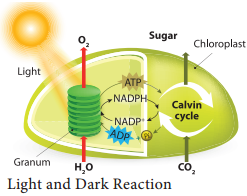Learninsta presents the core concepts of Biology with high-quality research papers and topical review articles.
Modern Concept of Photosynthesis
Photosynthesis is an Oxidation and Reduction process. Water is oxidised to release O2 and CO2 is reduced to form sugars. The first phase requires light and is called light reaction or Hill’s reaction.
1. Light Reaction:
It is a photochemical reaction whereas dark reaction is a thermochemical reaction. Solar energy is trapped by chlorophyll and stored in the form of chemical energy (assimilatory power) as ATP and reducing power NADPH + H+, NADPH + H+ alone are known as reducing powers. This reaction takes place in thylakoid membrane of the chloroplast. Oxygen is evolved as a result of splitting of water molecules by light.
Light reaction is discussed in two phases:
(i) Photo-Oxidation Phase:
- Absorption of light energy.
- Transfer of energy from accessory pigments to reaction centre.
- Activation of Chlorophyll ‘a’ molecule.
(ii) Photo Chemical Phase:
- Photolysis of water and oxygen evolution
- Electron transport and synthesis of assimilatory power.
2. Dark reaction (Biosynthetic Phase):
Fixation and reduction of CO2 into carbohydrates with the help of assimilatory power produced during light reaction. This reaction does not require light and is not directly light driven. Hence, it is called as Dark reaction or CalvinBenson cycle (Figure 13.9).

photosynthesis, the process by which green plants and certain other organisms transform light energy into chemical energy. During photosynthesis in green plants, light energy is captured and used to convert water, carbon dioxide, and minerals into oxygen and energy-rich organic compounds.
During photosynthesis, plants take in carbon dioxide (CO2) and water (H2O) from the air and soil. This transforms the water into oxygen and the carbon dioxide into glucose. The plant then releases the oxygen back into the air, and stores energy within the glucose molecules.
Recent advances include combining photosystem complexes with hydrogenases for hydrogen production, using isolated thylakoids, photosystems on nanostructured electrodes such as gold nanoparticles, carbon nanotubes, ZnO nanoparticles for electricity generation.
The process by which green plants make their own food (like glucose) from carbon dioxide and water by using sunlight energy (in the presence of chlorophyll) is called photosynthesis.
Green plants are the main producers of food in the ecosystem. All other organisms directly or indirectly depend on green plants for food. The process of photosynthesis also helps in maintaining the balance of carbon dioxide and oxygen in the air.
The three events that occur during the process of photosynthesis are:
- Absorption of light energy by chlorophyll
- Conversion of light energy to chemical energy and splitting of water molecules into hydrogen and oxygen
- Reduction of carbon dioxide to carbohydrates.
Photosynthesis and respiration, both using electron flow coupled with phosphorylation, have a common origin (‘conversion hypothesis’), but photosynthesis came first. Anaerobic (nitrate or sulphate) respiration cannot have preceded photosynthesis as neither nitrate nor sulphate existed on the early earth.
It fixes and balances the amount of carbon dioxide and oxygen in the atmosphere by plants exhaling oxygen and animals and humans exhaling carbon dioxide. It helps in the synthesis of organic compounds from inorganic compounds. It provides nutrition to the plants and thus helps in their growth and development.
The first stage of photosynthesis is called the light reactions. During this stage, light is absorbed and transformed to chemical energy in the bonds of NADPH and ATP.
The Light Reactions of Photosynthesis. Light is absorbed and the energy is used to drive electrons from water to generate NADPH and to drive protons across a membrane. These protons return through ATP synthase to make ATP.
Scientists think that glycolysis evolved before the other stages of cellular respiration. This is because the other stages need oxygen, whereas glycolysis does not, and there was no oxygen in Earth’s atmosphere when life first evolved about 3.5 to 4 billion years ago.